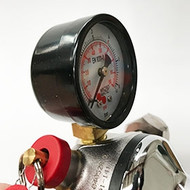Fermenting Under Pressure
By Greig McGill
There’s been a bit of buzz lately around fermentation under pressure. It’s been a tool in the arsenal of industrial brewers for decades now, but is there any benefit to home brewers? In this article, I’ll look at the available research, some of the anecdotal claims, and provide some information for you to draw your own conclusions on the benefits or otherwise of this technique.
Since the 60s, industrial brewers have known that applying pressure to the later stages of their lager fermentations allowed them to reduce the deleterious effects of their efforts to ferment faster at warmer temperatures. As it was generally lager production they were concerned with, there was little research into the effects of pressure on ale yeast fermentations. Many simply took it for granted that applying pressure during the late stages of fermentation of ales would have the same effect of reducing the production of vicinal diketone (VDK) precursors – a family of compounds of which diacetyl is the most commonly known. The other desirable outcome when fermenting with lager yeast strains under pressure was a reduction in the creation of fusel alcohols – those hot, solventy, unpleasant compounds produced by stressed yeast fermentations.
It took until the mid 1980s for researchers at Heriot-Watt University in Edinburgh to actually test the effects of attempting the same pressure applications used in lager production on ale strains. What they found was pretty much the opposite of the desired outcome! All was fine at low-ish pressures – up to one fifth of extra atmospheric pressure in CO2. At this level, often achieved naturally during fermentation depending on fermenter geometry, yeast growth is stimulated, and increased colonies of healthy yeast do indeed reduce fusels and VDK precursors. Above this point, things start to get a bit hairy, as yeast growth is inhibited up to around 2.5 atmospheres of CO2, where yeast cell division becomes impossible. In between these two points, fermentation rate, yeast growth, and VDK precursors all increase. A side effect of this is an increase in pH also, due to reduced yeast growth and thus simply fewer yeast cells in suspension. The only positive effect is a reduction in fusel alcohols.
Another interesting by-product of fermentation under pressure in both ale and lager strains is the increased production of lipids and fatty acids. These play an important role in yeast metabolism and health up to a certain point, but above that point, they have a negative effect on the yeast's ability to metabolise sugar to alcohol, and reproduce. As a result, collecting yeast for re-pitching from a too-high pressure fermentation could lead to major fermentation problems down the line. This is only a serious problem under the more extreme pressure levels as, at more sensible levels, it may only cost you a generation of yeast. This might be more than justifiable for the convenience trade-off of collecting yeast under pressure.
So, there’s the downside… pressure during ale fermentation has little positive effect and a whole bunch of potential problems. What about the upside? Well, I have some good news! Adding a bit of pressure can make many aspects of your brewing process more sanitary and easier. Simply capping a fermentation when nearly complete will help carbonate the beer naturally, saving you time and money in the form of reduced CO2 usage. When you transfer your beer, doing it under CO2 pressure means no oxygen pickup. A pressurised fermentation vessel also provides a simpler method of dumping yeast and trub, allowing you to ferment, condition, and maybe even serve your beer all from a single vessel! That’s not to be sneezed at. If you want to start reaping these benefits, we can help!
How about flavour then? Is there any positive impact of pressurised fermentation of beer flavours? There’s a lot of “it works for me” style anecdotes lurking on all the usual brewing forums. In terms of quantifiable sensory analysis though, the awesome Marshall Schott over at Brülosophy has done a series of xBmts designed to test the sensory impact of fermentation under pressure. The results so far? No significant differences, and one fermentation attenuation problem.
In conclusion, pressure fermentation was implemented to let industrial brewers produce more beer faster, while minimising but not eliminating the down sides of treating their yeast so poorly. As home brewers, there are no such financial or resource constraints to drive this behaviour, and it certainly doesn’t seem to have any measurable flavour benefits. There are, however, plenty of process benefits to be gained. So long as we remember to care for our best friends, the yeast, and not take things too far in terms of pressure application, these techniques can provide welcome time savings. This means more time available for drinking the results! How can that be a bad thing?
